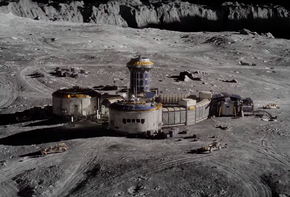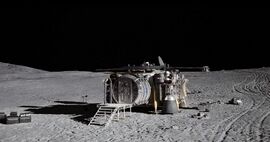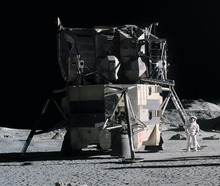Haller Base
This article is incomplete because it is pending further input from participants, or it is a work-in-progress by one author. Please comment on this article's talk page to share your input, comments and questions. Note: To contribute to this article, you may need to seek help from the author(s) of this page. |
Haller Base Lunar Station | |
|---|---|
 Haller Base facilities on the surface in 2008 | |
| File:Location of Haller Base.png | |
| Sovereign state | |
| Location on Luna | Jenssen crater, Soguichi Plateau |
| Administered by | Lunar Exploration Initiative of the MAOA and Air Force |
| Established | 9 November 1987 |
| Retired | 15 February 2009 |
| Named for | Emil G. Haller |
| Population (1987 / 2008) | |
| • Total | 5 / 13 |
| Type of operation | |
| • Crew | All year-round |
| Operation | |
| • Status | Inoperational |
| Dimensions |
|
| Facilities | 6 buildings and facilities:
|
Haller Base, officially the Haller Base Lunar Station (Hesurian: Haller-Basis Lunare Forschungsstation), is a Mascyllary research station in the Jenssen crater of the Soguichi Plateau on the surface of Luna, the second planet of the world's binary planet system. It was operated under the Lunar Exploration Initiative (MLEI) jointly of the MAOA and Air Force from 1987 to 2009 and is considered to be the furthermost point of Mascyllary jurisdiction and only one on Luna. The base is named in honour of rocketry pioneer and polar explorer Emil Haller who was a significant contributor to the foundation of the MAOA and its early human spaceflight projects.
Haller Base is the first modular planetary station and first large man-made structure on Luna, and was assembled by three separate missions from 1987 to 1999. The original base, less than a fifth of the completed station's volume, landed as part of the Sigma-Haller mission on 9 November 1987 by the space agencies of Mascylla and Dulebia as part of the Sigma program. With the Haller 87 and Haller 88 missions, the base became the first continuously inhabited research station on Luna and still maintains the longest duration of continuous human presence in space at 4,018 days. Since, the station has hosted up to 117 astronauts, the largest number for any Lunar research station, and has been repeatedly partially rebuilt and expanded upon. By 2008, Haller Base encompassed five pressurized modules, and two unpressurized components, the Wilhelm G. Neumayer Astronomical Observatory and the power-supplying photovoltaic array.
The station was purposefully constructed to and served as a research laboratory which enabled crews to conduct scientific experiments on human biology, microgravity and radiation physics, astronomy, meteorology and space physics and study the effects of long-term stay in space on humans. While the base operations and crew were militaristic in nature, it allowed scientific endeavours such as international collaborations with other countries to access the station. Haller 87 sustained five crew members, but the station's population continued to grow through its operation, with a peak 13 crew members of Haller 04 simultaneously on the station. In service from 1987 to 2009, Haller Base continued human presence on Luna, before it was agreed upon by the MLEI to retire the station in February 2009 mainly due to its aging hardware, damages sustained by meteorological phenomena and regolith exposure. The station has since been unoccupied and plans to either repurpose it for another settlement or preserve it as a protected area have been proposed.
Structures
Original base (1987–1989)
Construction and Sigma-Haller Expedition
The initial first component of the station, the pressurized Falkenhall Main Service Block (Hauptbetriebsblock; MSB) module and its adjacent solar arrays measuring 4,000 m2 of operable area, were manufactured at the Gräbler Spaceflight Center near Rothenau, Aldia, beginning in 1982. The name Falkenhall was ultimately chosen by MAOA in reference to the oldest continuously inhabited urban settlement in modern-day Mascylla, having been founded by 600 BC. The modules were delivered on ship to the Spacecraft Processing Facility and Main Flight Operations Building at Cape Weimud Space Center in Akawhk in August of 1987 for final inspections, processing and preparation for launch. The module was designed with three docking ports suitable for berthing operations, three autonomous arrays of solar cells measuring 4.5 by 1.3 meters (14.7 by 4.3 feet) mounted on its roof, six nickel-cadmium batteries with a capacity of 4 kilowatts of power, ten externally mounted fuel tanks holding 8.8 tonnes of propellant, and is outfitted with early communications and control equipment. Falkenhall has a dry mass of 21,492 kilograms (47,382 lb), is 8.2 meters (26.9 ft) long and 4.1 (13.5 ft) meters wide.

Falkenhall was launched on 6 November 1987 on a purpose-built and modified version of the Atlant-3 rocket from Cape Weimud in Akawhk; the mission was incorporated into the Sigma program as the Sigma-Haller Expedition, crewed by a joint Dulebian-Mascyllary crew of Mission Commander Janus Heine. After the initial launch and the first two stage separations, the payload ascended to a 500 km (311 mi) high parking orbit for re-configuration and trans-lunar flight preparations before firing the CSM third upper stage for trans-lunar injection on 7 November. On 9 November, the two-stage Falkenhall module and its cargo load, referred to as LM-13 Dnepr, separated from the Sigma Command and Service Module (Kommando- und Betriebsmodul; CSM) Antares, having ferried it to lunar orbit, and descended to Luna's surface; Dnepr touched down at the ridges of Jenssen crater of the Soguichi Plateau at 05:22 UTC. The three astronauts stayed on the newly established lunar base before returning to the CSM in low orbit; the base module served as the launch pad for the ascent stage, similar in operation to the Sigma Lunar Module (Lunarmodul; LM), which then docked with CSM-98 Antares again and was subsequently discarded. After 6 days of stay and the 4 days of travel following the trans-Aurorum injection, the crew of the Sigma-Haller Expedition returned to Aurorum on 18 November.
Complications and modification
The ascent stage of Dnepr inadvertently polluted the photovoltaic arrays with whirled up lunar regolith, which caused Falkenhall to suffer a blackout one day after Sigma-Haller's departure. Contact to the automatic systems of the station remained severed until the Haller 87 Expedition was able to clean and re-orientate the solar arrays while moving them 700 meters (2,297 feet) away from the designated but improvised landing and take-off site, two weeks later in December of 1987. During the Haller 88 Expedition in July of 1988, a repurposed descent propulsion system similarly used in the LM descent stage was utilized to blow away possibly hazardous or inhibiting regolith from the designated site and heat the material to fuse it into a durable and hardened platform. After installing edge and status lighting, LM-17 Heiserer of the Haller 89 Expedition was the first to land on the Sahalinov Landing Site (Sahalinow-Landungsplatz; SLS); in 1994, a second SLS including seven additional external fuel storage tanks were constructed 30 meters (98.4 ft) away from the first SLS.
Added modules (1989–1999)
Assembly
The construction of Haller Base was a major and ultimately multi-national undertaking in space and lunar architecture. The initial assembly began in November 1988 during the Haller 89 Expedition when two Base Node Module Adapters (Basisknotenmoduladapter; BNMAs) were attached to the passive Falkenhall module by two astronauts performing extra-vehicular activities, serving as nodes for future additions. Over the course of Haller Base's assembly, astronauts used some 1,100 hours of EVA operations as well as the Mobile Servicing Robotic Unit (Mobiles Betriebsrobotikeinheit; MSRU) as the base expanded in size and complexity. Similarly, since the Haller 93 Expedition, Haller Base was serviced and supplied by an evolved and heavy-payload five-astronaut version of the 1980s Sigma LM, the Lunar Surface Access Module (Lunares Modul für Oberflächenerkundung; LSAM); because the first active LSAM was LM-19 Fischadler, it is sometimes referred to as Fischadler ("osprey") by itself.
Elements
On 30 July 1989, the H-2B Crew Compartment and Science Module (Truppenabteil und Wissenschaftsmodul) was launched into orbit and then delivered to Luna via the Haller 90 Expedition. The H-2B–Sagittarius vehicle performed the descent and docking to the Falkenhall-BNMA complex part-automatically and part-manually. Serving as the new operational centre of Haller Base, the H-2B module's computer system autonomously assumed control over the base from Falkenhall's systems, and was equipped with designated crew and sleeping quarters, a kitchen, multiple toilets and sanitary systems, and exercise equipment. Additionally, the scientific compartment of the large cylindric module, measuring 13.3 meters (43.6 ft) in diameter, supplemented the Falkenhall life-support systems with CO2 scrubbers, dehumidifiers, wastewater treatment systems, and oxygen generators. Mission Commander Felix Ahrndt later recalled the happiness and gratitude of subsequent Haller Expedition astronauts who stayed in the base before the expansions in 2011, commenting: "By this point Falkenhall was, well, "overcrowded" would be an understatement. It was like a tan of sardines, speaking from experience and talking to other Haller astronauts, and everyone talked about how happy they were that they now could take more than eight steps in any direction. H-2B was like a cathedral in comparison to the old Falkenhall lady."


